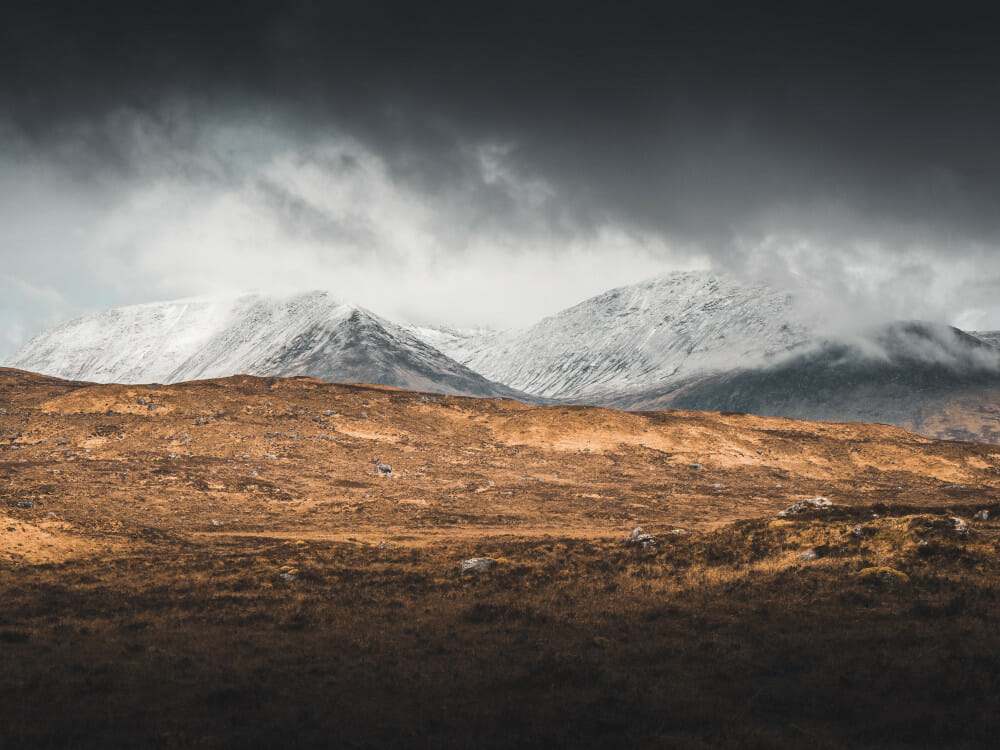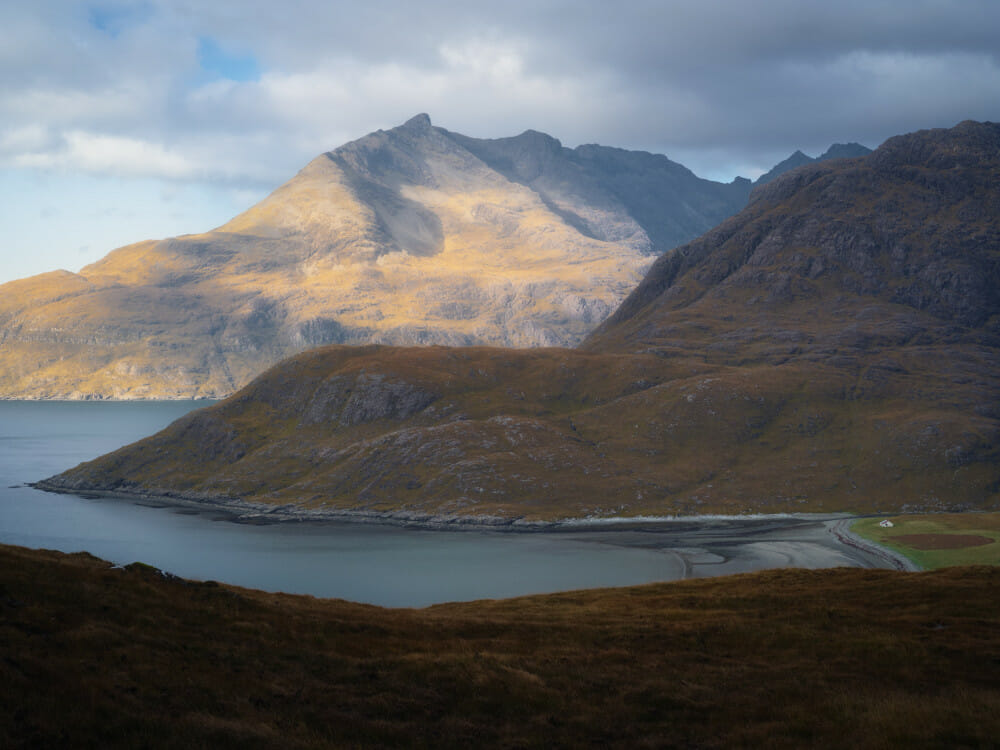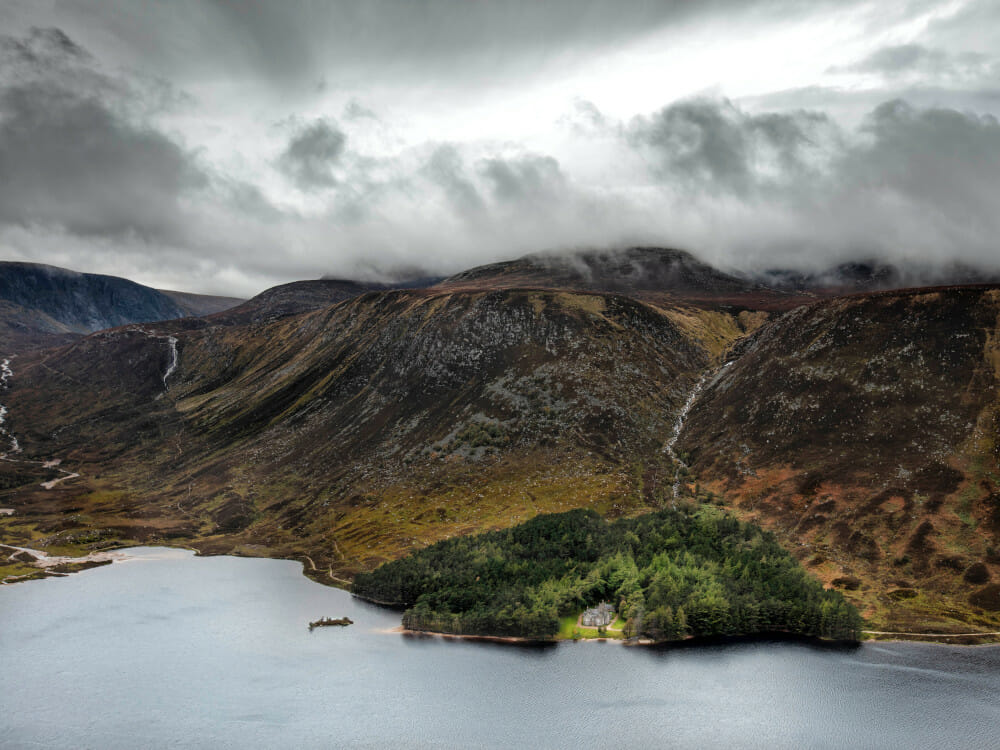Despite its location on the edge of Europe, Scotland can be reached quickly and easily by hikers. Access roads are as well developed as local infrastructure. Glasgow and Edinburgh are two metropolises that can be reached directly from Europe. The road and rail network quickly leads to all parts of the country from there. Glasgow is located in the west and provides access to the West Highlands and the fjord coast, while the Scottish capital Edinburgh is situated by the North Sea, representing the gateway to the central and eastern parts of Scotland with its very wide landscapes.
A physiographical overview
There are all types of landscapes: moors, heathland, forests, mountain ridges, individual mountains, valleys, plateaus, gorges and lakes of all sizes. Scotland can be divided into three wide strips that run from the south west to the north east. The most southern strip consists of the Lowlands which are located around the two major cities Glasgow and Edinburgh. Around 40% of the 5.5 million Scots live there. 20 kilometres north of Glasgow, the Lowlands become the Grampian Mountains, the largest Scottish mountains that feature rocky high plains. “Behind” the Grampians – which must not be confused with their Australian namesake – is the tectonic Glen Coe. This glen runs in a straight line from Fort William on the Atlantic to Inverness on the North Sea. At a length of 96 km, it marks the narrowest part of Scotland and accommodates, in addition to other lakes, the famous Loch Ness.
The West Highlands and the Northwestern Highlands are located beyond Glen Coe. The group of Atlantic islands, the Inner and Outer Hebrides, form the outer “frame” of it all. The island of Skye is part of the Inner Hebrides. It can be accessed via a road bridge and is a top destination for tourists. In addition to the wild coastline, castle and fort ruins in dramatically rugged landscapes are popular motifs for pictures.
As another rough categorisation of the Scottish landscape, the following applies: the mountain summits become steeper and more impressive from the east to the west but clouds and rain also increase towards the Atlantic. Which neatly takes us to the different areas for walks in Scotland.
Regions for hikes in Scotland
West Highlands and Grampians
The fact that hiking in Scotland is worthwhile and incredibly attractive is no longer a secret. From mountain and climbing tours to long-distance routes and walking trails around idyllic towns: there’s something for everyone. The network of hiking trails has been developed for decades, generally with reason and sound judgement. The splendid hiking regions of the Trossachs and Cairngorms National Parks are particularly well developed and signposted, as are the southern West Highlands. This is where some of the popular long-distance trails like the West Highland Way and Great Glen Way are located.
The Grampian Mountains or Grampians form the central and eastern part of Scotland. In the south, they extend to the Atlantic coast, west of Glasgow. In this outer southern and western part also lies Fort William, the centre of Scottish mountain sports at the foot of Ben Nevis (1,344 m), the highest mountain in the British Isles. The fact that its summit is surrounded by cloud around 360 days of the year did not seem to be an obstacle for building an observatory. Although now, this building is no longer in use as an observatory. The notoriously terrible weather neither seems to be an obstacle for the year-round action on the ridges and in the gullies of the northern and eastern faces of the mountain measuring up to 500 metres. During the winter, it’s all about serious climbing, vertical ice, pickaxes, crampons and spindrift, just like in high Alpine regions.
In some areas of the West and Northwest Highlands , the description “wilderness” is not exaggerated at all. In the Northwest Highlands in particular, you may find yourself in hundreds of square kilometres of countryside without any trace of human life apart from hiking trails and shepherds’ tracks. A famous example of such wild terrain is Knoydart on the central west coast. Further north, too, in Assynt and in Sutherland, you can roam around for days without markers or human contact. In this areas, many will prefer joining an organised tour.
Groups of islands
Scotland is surrounded by several groups of islands: the Hebrides in the west as well as the Orkney and Shetland Islands in the north. Some of the best hiking places can be found on Skye, the Inner Hebrides Island, which attracts a lot of walkers. The summits are not just tricky concerning the pronunciation of their names but they’re also some of the steepest and most challenging when it comes to mountaineering in Scotland. One of the most popular hills to climb in Scotland and a great test of skills is “Black Cuillin Ridge Traverse”. In addition, those visiting Skye will also see Scotland’s two most famous photo motifs to the north of the only town – Portree: the rock pinnacle Old Man of Storr and the wild Quiraing coastal and mountain formation.
Peculiarities and specialities
Much like the rest of the British Isles, Scotland is famous for its long history with a rich culture and many, sometimes quirky traditions. And for the pronounced and quite special mentality of its inhabitants which may be summarised as “tough”.
Since almost everything is special and unique, we’ll only focus on the characteristics that Alpine Trekkers and those hiking in Scotland should be aware of.
First of all, there’s the wildness of nature as just mentioned. Be careful not to underestimate it because it’s “only” Europe rather than North America or Central Asia. This underestimation also includes the size and vastness of the countryside. In areas that don’t feature woods, there is often no shelter that would offer protection from the elements. Insufficient route planning or a lack of equipment have, for many hikers, resulted in dangerous situations far away from any help.
Scotland’s harsh climate, on the other hand, is quite well known – among hikers as well. The Atlantic may mitigate it with the Gulf Stream, but this also results in a lot of rain and moisture. And since we’re talking about somewhere between the 55th and 60th degree of latitude, the level of mitigation must be considered as relative. For Alpine Trekkers, it means the following: fog will appear quickly, rivers will swell significantly after rainfall and snow can cause surprises even in the summer. Bad weather can persist for long periods during any season, which can lead to mental problems that also manifest physically. Of course, damp, wind and cold quickly lead to fatigue anyway.
Munros, Corbetts and Grahams
A classic Scottish novelty is the division of the local mountains in “Munros”, “Corbetts” and “Grahams”. Munros are mountains higher than 3,000 feet (= 914 m), Corbetts measure between 2,500 and 3,000 feet and Grahams have a height between 2,000 and 2,500 feet. Depending on autonomy and topographic prominence, the mountains are further categorised as “Munro-Tops” or “Donalds”. They also sometimes have female names like “Fiona” and “Marilyn”. Mountains and hills of any height are referred to as Marilyns if they have a free gradient of at least 150 metres on all sides. That means they really stand out from their surroundings.
Because there are many categories and differentiations (which can’t all be elaborated on for reasons of space), allocations of summits aren’t always clear and not everyone consistently “complies” with the terminology.
The Scottish wouldn’t be the Scottish if they hadn’t combined sports, games and a passion for collecting in this. In the 19th century, for example, Sir Hugh Munro was not only the first creator of a complete Munro list but also the first collector of these summits. And therefore the first “Munro Bagger” or collector. However, he wasn’t the first “Munroist” with all 283 (today 282) summits collected, but a certain Reverend A.E. Robinson in 1901. Today, there are around 38,000 people who have immortalised themselves online in the list of Munroists after completing the mission.
As we all know, the highest Munro is Ben Nevis at 1,344 m. The most difficult one featuring Grade 3 climbing passages has the very fitting name Inaccessible Pinnacle and is located on the Isle of Skye.
Let’s now look at a very unpleasant special feature of Scotland hiking in the Highlands – midges. It’s practically impossible to get away from these little blood-sucking flies during the summer months of July and August. They love to wait around in calm and shady areas of Scotland’s walking trails to rain down on hikers in swarms. The usual chemical or electric bug repellents are of hardly any use. The only solution, apart from falling temperatures, is a mild breeze. Or the combination of a very dense mosquito net for your face and the “Skin so Soft” skin moisturiser that can be bought in many hikers’ shops in Scotland. The following rule of thumb relating to midges applies: the slightly drier areas in the east and in the Central Highlands are less “polluted” than the west.
Midges
Let’s now look at a very unpleasant special feature of Scotland hiking in the Highlands – midges. It’s practically impossible to get away from these little blood-sucking flies during the summer months of July and August. They love to wait around in calm and shady areas of Scotland’s walking trails to rain down on hikers in swarms. The usual chemical or electric bug repellents are of hardly any use. The only solution, apart from falling temperatures, is a mild breeze. Or the combination of a very dense mosquito net for your face and the “Skin so Soft” skin moisturiser that can be bought in many hikers’ shops in Scotland. The following rule of thumb relating to midges applies: the slightly drier areas in the east and in the Central Highlands are less “polluted” than the west.
Mentality and outdoor ethics
When talking about special features of Scotland, we mustn’t forget to mention the idiosyncrasies of the people. These take what is already the tough Alpine mentality of the British to the next level. After all, they live with even worse weather. And with small yet excellent mountains that can turn properly Alpine in the winter. Which seems to be the preferred time for the Scottish to climb them.
Hiking tourists benefit from the very sporty British-Scottish mindset because it means the local infrastructure is perfectly adapted to the needs of outdoor enthusiasts and Alpine Trekkers. The quantity and quality of trips and Highland trails is as plentiful as the information. There are many high-quality articles, books, guides and websites. On location, too, of course, in centres such as Fort William in particular.
Also good news is that wild camping is handled to suit Alpine Trekkers, as Alpine Trekker Lisa found out for us as follows:
“In Great Britain, there is no standardised rule about wild camping. England, Wales and Scotland all have their own, very different laws. However, wild camping is officially permitted only in Scotland. Conduct outdoors in the wild is governed by the Scottish Outdoor Access Code. This is a type of binding code of conduct with all key dos and don’ts. Of course, there are also areas like nature reserves or private property that are subject to separate regulations. But outside these areas, camping and bivouacking is permitted, but just for one night.”
Thanks to these “user-friendly” rules, the Highlands can easily be explored as part of long-distance hikes or trekking tours.
Further information
And finally, three browsing tips to ensure that your next trip includes the best walks in Scotland:
The British Wanderlust Magazine with the “13 best hikes” in Scotland.
Walkhighlands – complete info portal related to hiking in Scotland.
Mountaineering – comprehensive info portal for hiking, climbing, camping and winter mountaineering.










1 Comment on the Article
Hi there, correction needed; Glen Coe is to the south of Fort William. The tectonic Glen you mention that runs between Fort William on the Atlantic, and Inverness on the North Sea is actually The Great Glen. I.e. the Glen you walk along when following the Great Glen Way from Fort William to Inverness! I live in The Great Glen, so please be assured this is correct!